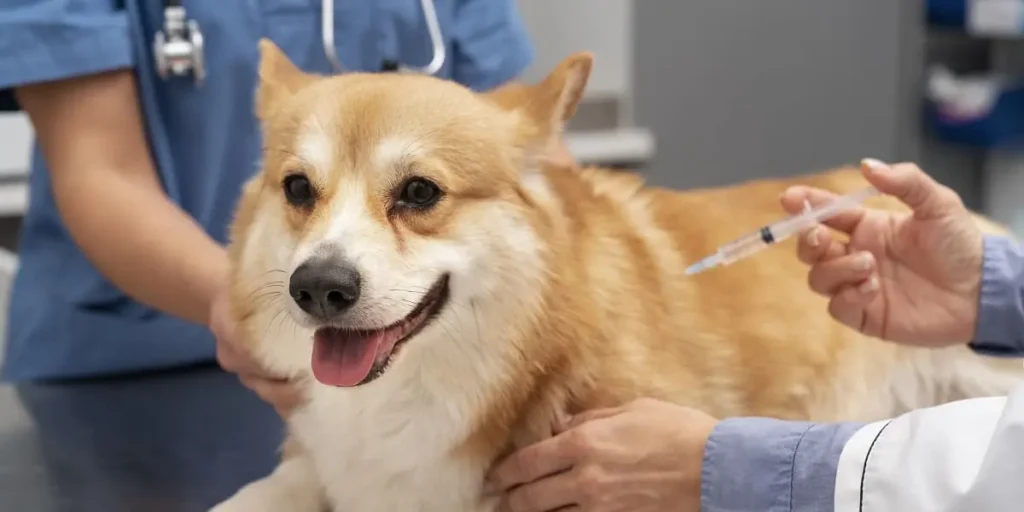Table of contents
- Key Takeaways
- When to Vaccinate a Puppy or Adult Dog?
- Which Vaccines Are Mandatory?
- Recommended Core Vaccines for All Dogs
- Complementary Vaccines
- Boosters: How Often? Do Dogs Need Annual Shots?
- Until What Age Should Dogs Be Vaccinated?
- How to Keep Track of Your Dog’s Upcoming Vaccines?
- Price: How Much Does a Booster Cost?
- What Are Possible Side Effects in Puppies or Adults?
Vaccination is a preventive measure that follows a defined protocol. It uses vaccines with inactivated or weakened agents to stimulate the immune response. Below are the main dog vaccines and the recommended schedule.
Key Takeaways
- The only mandatory vaccine is rabies for cross-border travel or regulated categories of dogs.
- Other vaccines are not legally required but strongly recommended.
- Puppies can start vaccinations at 8 weeks of age.
When to Vaccinate a Puppy or Adult Dog?
- Puppies: start at 8 weeks. Initial (primo) vaccination usually involves 3 injections at 8, 12, and 16 weeks. A booster is given at 1 year, then annually. Additional vaccines may be advised based on lifestyle and are scheduled separately.
- Adult dogs: can begin at any age with 2 injections one month apart, then annual boosters for core vaccines. Lifestyle vaccines also require separate scheduling and may need 1 or 2 initial doses.
| Dog Age/Status | Initial Series | Boosters | Additional Vaccines |
| Puppy (8–16 weeks) | 3 doses: 8, 12, 16 weeks | 1-year booster, then yearly | Based on lifestyle; separate timing |
| Adult dog | 2 doses, 1 month apart | Yearly for core vaccines | Separate timing; 1–2 initial doses |
Which Vaccines Are Mandatory?
Rabies is the only vaccine regulated by law and becomes mandatory in specific cases.
Rabies is a fatal viral disease affecting mammals worldwide and can be transmitted to humans. Although eradicated in France since 2001, strict surveillance prevents reintroduction, especially via animal imports.
For international travel, dogs must be vaccinated against rabies, microchipped, and have a passport. The first rabies dose is usually a single injection at or after 12 weeks, followed by a booster after one or three years. Legal validity starts 21 days after the first injection.
Certain regulated dog categories must also be vaccinated against rabies.
Recommended Core Vaccines for All Dogs
Five essential vaccines are strongly recommended for all dogs. They are often administered together from 8 weeks of age, with 2 or 3 initial doses, a booster at 1 year, and yearly boosters thereafter documented in the dog’s health record.
Canine Distemper (C)
A highly contagious viral disease that mostly affects unvaccinated puppies, causing fever, coughing, nasal discharge, vomiting, diarrhea, and even neurological symptoms. It can be fatal if untreated.
Infectious Canine Hepatitis / Rubarth’s Disease (H)
Adenovirus that affects a dog’s liver, kidneys, and eyes. It spreads through contact with infected body fluids and can cause fever, loss of appetite, dehydration, jaundice, and serious liver problems.
Parvovirus (P)
A highly contagious viral disease spread through contaminated feces. It causes bloody diarrhea, vomiting, dehydration, and weakness, and is often fatal in puppies.
Canine Influenza (Pi)
Two strains of this virus cause a respiratory illness marked by coughing, nasal discharge, fever, tiredness, and loss of appetite. It’s rarely fatal but spreads quickly among dogs.
Leptospirosis (L4)
A bacterial infection spread through contact with urine from infected animals or contaminated water. It’s zoonotic, meaning it can infect humans too, and may cause fever, tiredness, muscle pain, vomiting, and kidney damage. It can be life-threatening if not treated.
National data indicate increased uptake of core vaccines (distemper, hepatitis, parvo, leptospirosis) in recent years.
Complementary Vaccines
These can be added based on lifestyle and risk exposure.
Leishmaniasis (Le)
A parasitic disease transmitted by sand flies, mainly found in Mediterranean regions. Symptoms include weight loss, skin sores, kidney issues, and enlarged lymph nodes. Vaccination is recommended for dogs that frequently travel to risk areas. It can start at 6 months of age, should be scheduled 1–2 months apart from other vaccines, given as a single initial dose, and followed by yearly boosters.
Piroplasmosis / Babesiosis (Piro)
A tick-borne disease (Babesia spp.) that causes high fever, anemia, loss of appetite, and dark-colored urine. Vaccination is recommended for dogs living in or traveling to areas with heavy tick populations. It can begin at 6 months of age, should be scheduled separately from other vaccines, given as two initial doses, and followed by an annual booster.
Kennel Cough (Tx)
A highly contagious respiratory disease that spreads easily in places where dogs are in close contact, such as shelters, boarding facilities, and training classes. Many boarding centers require this vaccine. It can be given along with core vaccines, with one or two initial doses depending on the product, followed by yearly boosters.
Boosters: How Often? Do Dogs Need Annual Shots?
Example protocol for a puppy frequenting southern France, sometimes traveling abroad, and occasionally boarded:
| Age | Vaccines Administered |
| 8 weeks | CHPPiL4 (Distemper, Hepatitis, Parvovirus, Influenza, Leptospirosis) |
| 12 weeks | CHPPiL4 + Rabies + Kennel Cough |
| 16 weeks | CHPPiL4 + Kennel Cough |
| 6 months | Leishmaniasis |
| 1 year | CHPPiL4 + Kennel Cough |
| 1.5 years | Leishmaniasis |
| 3 years | CHPPiL4 + Rabies + Kennel Cough |
Until What Age Should Dogs Be Vaccinated?
Senior dogs still need protection. With age, immune responses can weaken, so continuing vaccination helps maintain health and longevity.
How to Keep Track of Your Dog’s Upcoming Vaccines?
Veterinary clinics often send reminder letters or emails. Some laboratories offer free email/SMS reminders. A personal calendar or notes also work well.
Price: How Much Does a Booster Cost?
A vaccine appointment usually costs between $60 and $100, depending on your location, the clinic, the type of vaccine, and any additional services. This fee typically includes a full health exam to make sure your dog is healthy enough for vaccination.
Vaccination is highly cost-effective – for example, a parvovirus shot may cost around $60–$100, while treating parvovirus can easily reach $800 or more. Some pet insurance plans may also help cover vaccination expenses.
What Are Possible Side Effects in Puppies or Adults?
Most dogs tolerate vaccines well. Minor reactions can include mild fatigue for 24–48 hours or a small lump at the injection site that resolves on its own.
Severe allergic reactions are rare and occur mainly in dogs under 1 year and small breeds (<5 kg/11 lb). Breeds such as Poodles, Dachshunds, or Weimaraners may be more sensitive.
Monitor your dog during the 6 hours after injection. If facial itching, vomiting, or breathing issues occur, contact your veterinarian immediately.
Core and optional vaccines are strongly recommended. Booster shots aren’t always needed every year – your veterinarian will customize the schedule based on your dog’s age, health, and lifestyle.


